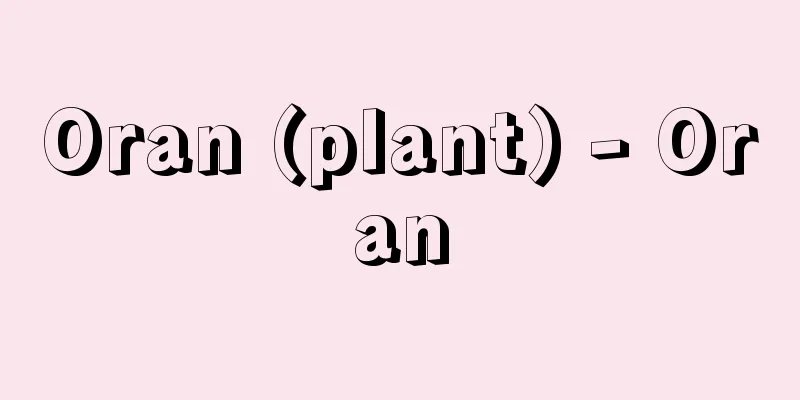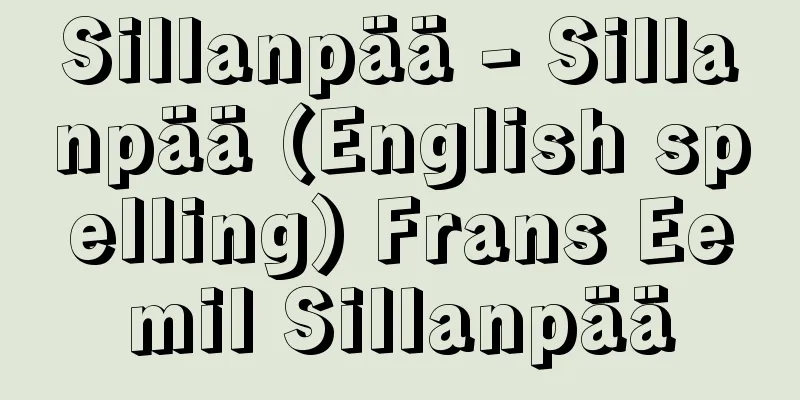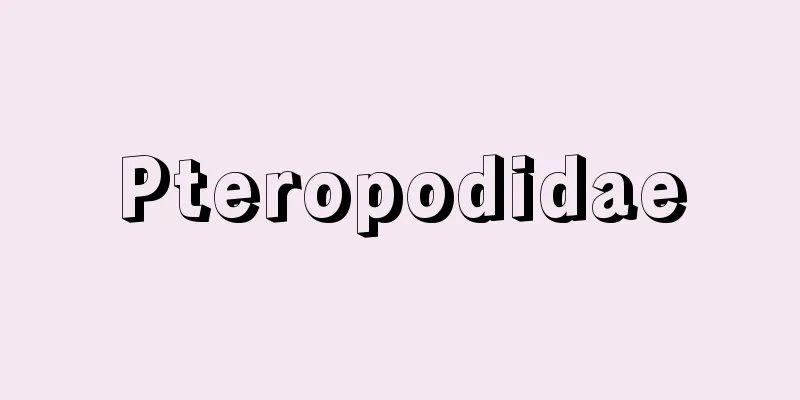Applique - Appliqué (English spelling) French

|
A craft term. Applique means to stick, attach, or place a piece of fabric on something. It originally started as a way to repair damaged or torn parts of clothing by placing a different piece of fabric on them. It is said that over time it came to be used for both practical purposes and decoration. [Kimura Mariko] OriginIt was widely developed in Europe during the Middle Ages, and was used for altar hangings, monk's robes, clothing, and interior decoration. It became commonly used in Japan around the end of the Meiji period, and was passed down under the name "cloth placement embroidery." Applique techniques are also found in the Ainu patterns of Hokkaido. [Kimura Mariko] techniqueFabrics of different colors and patterns are cut according to the design on top of a base cloth and then sewn together. Depending on the fabric, the reverse side may be lined with Japanese paper or other materials. In addition to fabric, knitted fabric, leather, lace, etc. may be used to create variation. Also, the "mola applique" made by the indigenous people living in the San Blas Islands in Central America and the Caribbean is made in a unique way. Mola means upper garment (blouse), and is worn by Kuna women as a blouse. This is made by layering several pieces of intensely colored fabric and cutting them to create different colors. Depending on the design, cloth may be placed partially on top or embroidery may be added. A characteristic of this style is that there is no pattern, and each person creates their own pattern. Legends and myths, as well as animals, birds, fish, snakes, snails, etc. that are around them are designed. The cut parts are folded inward and sewn. It is said that no two designs are the same. This is a very intricate and rare piece of folk art. In addition, recent applique techniques include those in which parts of the fabric are raised, separated, or set in place, as well as applique quilting that uses a core to create a three-dimensional effect. [Kimura Mariko] Stitches usedChain stitch, outline stitch, buttonhole stitch, satin stitch, coaching stitch, houndstooth stitch, blind stitch, machine stitch, etc. Glue and adhesives are also used. [Kimura Mariko] Suitable fabricsGenerally speaking, materials that do not fray easily are good. Tightly woven wool (felt, melton, etc. can be used cut off), corduroy, gingham, broadcloth, pique, plain cotton, linen, synthetic fabric, silk, velvet. Non-fabric materials include cord, chevron tape, bias tape, braid, chemical lace (cut into pieces), knitted motifs, etc. Special materials include leather, synthetic leather, fur, shells, buttons, plastic products, and thin metal sheets. [Kimura Mariko] ApplicationsIt is widely used in clothing, accessories, interior decoration, bags, rugs, lap blankets, stage costumes, curtain curtains, folding screens, flags, etc. [Kimura Mariko] Artwork made using the mola technique, an indigenous people of the San Blas Islands (Panama) ©Shogakukan "> Mola applique A wall hanging depicting a 12th century king ©Shogakukan "> Danish Applique ©Shogakukan "> Applique techniques Source: Shogakukan Encyclopedia Nipponica About Encyclopedia Nipponica Information | Legend |
|
手芸用語。アップリケとは、はる、とじつける、布置きするなどの意味で、古くは衣服の傷みかけた部分や破れたところに別布を置き補修することから始まった。やがてそれが、実用性と装飾を兼ねたものになったといわれる。 [木村鞠子] 由来ヨーロッパでは中世に大いに発達し、祭壇の掛け布、僧服、服飾や室内装飾に用いられた。日本で一般に使われたのは、明治末期ごろであり、布置き刺しゅうといわれて伝えられた。また、北海道のアイヌ模様にも、アップリケの技法がある。 [木村鞠子] 技法土台布の上に、色、柄の異なった布を図案どおりに切って置き、かがりつけてつくる。布地によっては、裏側に和紙などで裏ばりをする場合もある。布地のほかに編地、革、レースなどを使って変化を出すこともある。また、中央アメリカ、カリブ海のサンブラス諸島に住む先住民のつくる「モラのアップリケ」は、特異な方法でつくられる。モラとは、上衣(ブラウス)の意味であり、クナ人の女性のブラウスとして着られているものである。これは、強烈な色彩の布地を数枚重ねて、切り込むことによって違った色を出すもので、図案によっては上に部分的に布を置いたり、刺しゅうを加えることもある。特徴としてパターンはなく、各自が思い思いの柄を考えてつくる。伝説や神話、また、自分たちの身の回りにある動物、鳥、魚、ヘビ、カタツムリなどを図案化している。切り込んだところは内側に折り曲げてまつりつける。つくられたものに、同じ図案はないともいわれている。たいへん手の込んだ珍しい民芸品である。 また、最近のアップリケには、置いた布の一部を浮かしたり、離したり、はめ込んだりしたものや、芯(しん)を入れて立体感を出したアップリケ・キルティングなどもある。 [木村鞠子] 使われるステッチチェーンステッチ、アウトラインステッチ、ボタンホールステッチ、サテンステッチ、コーチングステッチ、千鳥かがり、まつり縫い、ミシン縫いなど。そのほか糊(のり)付け、接着剤も使われる。 [木村鞠子] 適した布地一般にほつれにくいものがよい。織り目の密なウール地(フェルト、メルトンなどは切りっぱなしで使うこともできる)、コーデュロイ、ギンガム、ブロード、ピケ、平織の木綿地、麻地、化繊地、絹地、ベルベット。布地以外ではコード、山形テープ、バイヤステープ、ブレード、ケミカル・レース(部分を切って使う)、編んだモチーフなど。特殊なものとして、革、合成皮革、毛皮、貝殻、ボタン、プラスチック製品、金属薄板など。 [木村鞠子] 用途服飾、アクセサリー類、室内装飾、袋物、敷物、膝(ひざ)掛け、舞台衣装、緞帳(どんちょう)、衝立(ついたて)、旗類など広く用いられる。 [木村鞠子] サンブラス諸島(パナマ)の先住民モラの技法による作品©Shogakukan"> モラのアップリケ 12世紀の王の姿を縫いとった壁掛け©Shogakukan"> デンマークのアップリケ ©Shogakukan"> アップリケの技法 出典 小学館 日本大百科全書(ニッポニカ)日本大百科全書(ニッポニカ)について 情報 | 凡例 |
Recommend
Voice dialogue - Onsei-wa
...If the dictionary has a vocabulary of around 2...
Industrial action
When a labor dispute occurs, a group of workers r...
Nabata ruins
<br /> The remains of a settlement in Nabata...
Large-leaved Japanese laurel - Large-leaved Japanese laurel
A climbing deciduous shrub of the Celastraceae fa...
Ranan
A city in the eastern part of North Hamgyong Prov...
Ara macao (English spelling) Aramacao
...There are about 15 species distributed around ...
Audiencia Bireinal - Audiencia Bireinal
…It was the longest-lasting and most stable of th...
Atypical Mycobacteriosis - Atypical Mycobacteriosis
[What kind of disease is it?] This disease mainly ...
Elephant - elephant
〘Noun〙① The shape of an object. The figure of a pe...
Phacops
…They may also form geographically distinct fauna...
Gregor, W. (English spelling) GregorW
...It is also called titanium. In 1789, the Briti...
《Bland Answer》 - A bland answer
...Graduated from Cambridge University. Her style...
Yutou - Yutou
This refers to a vessel for holding the scorched ...
Inca bone - Inca bone
When the part of the occipital bone that connects ...
Open cut method - Open cut method (English)
This method utilizes the stable gradient of the so...









